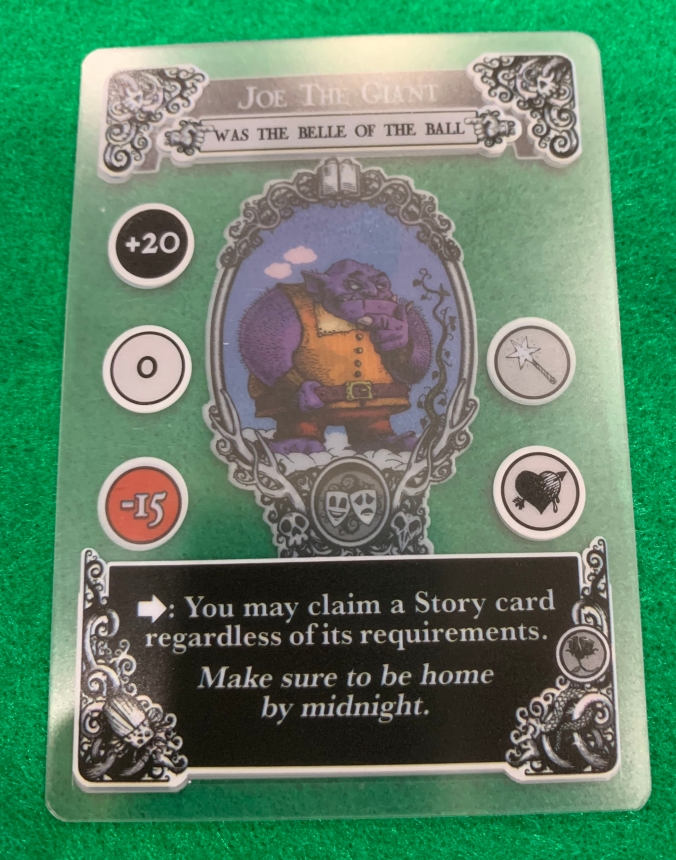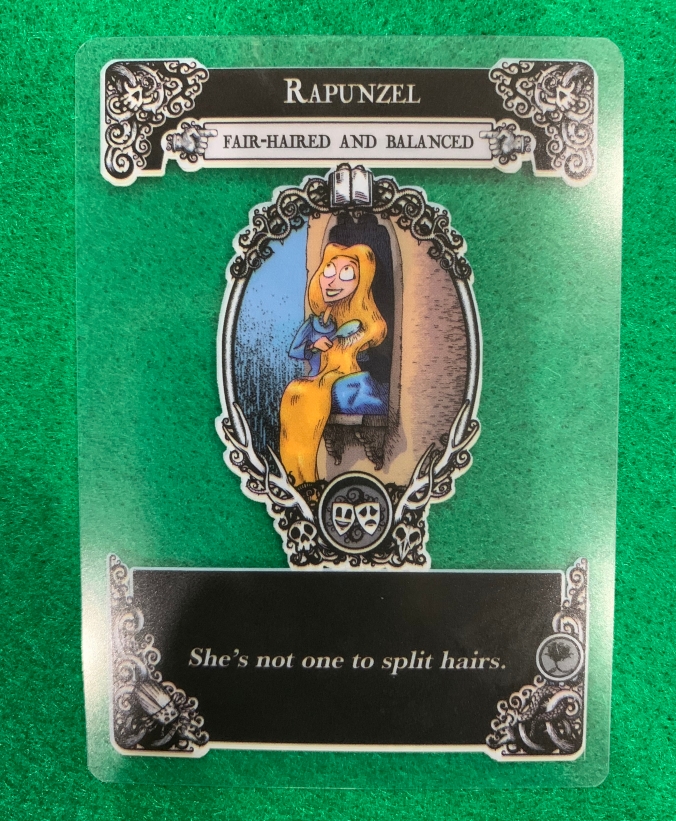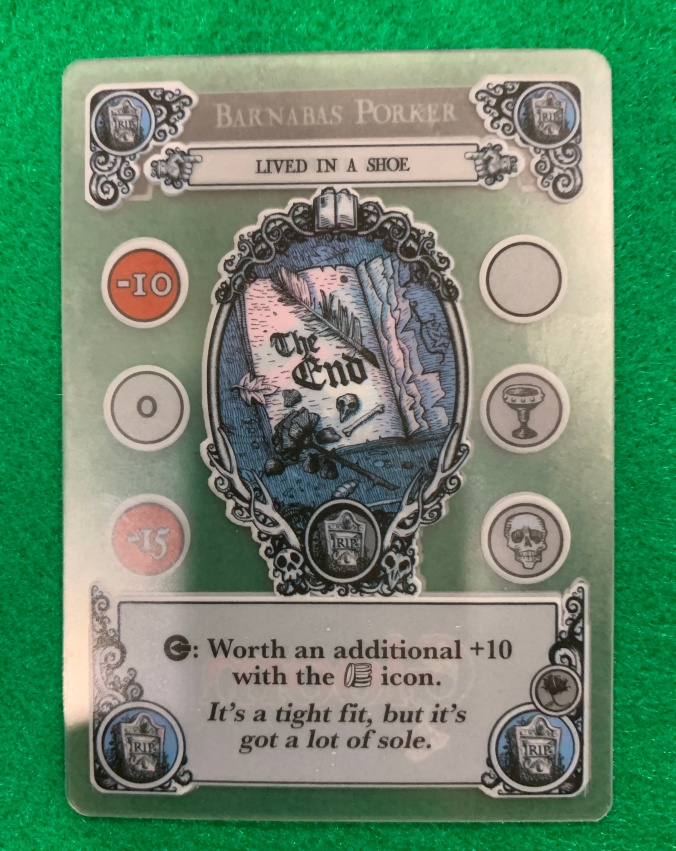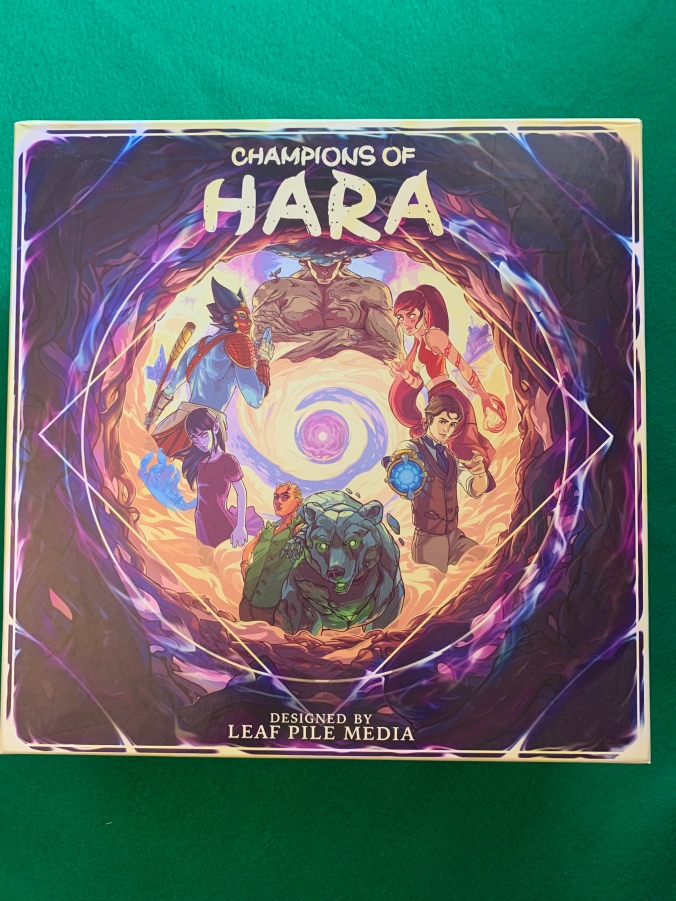If there is one thing that my daughter inherited from me is it the gift of storytelling, she is always asking me to tell her a story that I’ve made up, or entertaining me with one of her own. Many of her stories are based on experiences in her life, from the everyday, to even the games that we play together. After playing some of her favorite games, her creativity gets fired up, and she brings these worlds alive. From writing her own fan fiction story about her favorite game, Too Many Bones, to pretending that she is escaping a dark dungeon like in One Deck Dungeon. It’s amazing, as a Mom, for me to watch. She is now learning to read and write on her own, and this has opened up a new world for her, this includes all new games that she could not play before.
Enter one of my all-time favorite games, Gloom. I own a lot of versions of this game, I told you, it was one of my favorites, but I thought she might be most interested in Fairytale Gloom. Fairytale Gloom is the brainchild of Keith Baker, published by Atlas Games, and illustrated by Jaume Fabregat.

Unfortunately Gloom does not have a solo mode, so it was not coming to my table as often as I would have liked it to. On a whim, I took it out the other day, and showed it to Emmy. I could not have expected a better time. From the moment I described the game to her, she was hooked, and she was ready to play. I explained the objective and the rules. Here, let me do that for you too.
I any version of Gloom that you play the objective is always the same, be the first person to make your family, or in this case characters, so unhappy that they succumb to the dark and, well, die. I know, kind of bleak, and dark, right? Many of you might be questioning my parenting skills right now, but cancel that call to DCF, it’s not that bad. While the game does want you to off your people, getting them to the grave can be pretty challenging and hilarious. Fairytale Gloom sets its sights on beloved fairytale characters, Rapuzel, Big Bad Wolf, and even the beloved Cinderella are not safe from these sad tales.

Once you have chosen your victims, uh, I mean, characters, you are dealt a hand of five cards. two story cards are dealt to the middle of the table, more on that later, and play begins. Each player, on their turn can begin the game by weaving a backstory for their characters, a tale of misery, and woe. On each turn players are allowed two actions. You may play an event card, which has some immediate effect, these cards are one use and then discarded. You may play a modifier on one of your characters or an opponents character. These cards are the meat of the game, and will cause the characters to increase or decrease their self worth, effectively making them happier or more miserable. Modifiers have titles on them, usually alliterations, such as Purloined Porridge, or Trapped in a Tower. These titles or names are what will be weaved into the story that you are telling about your character. If played on an opponent you will also be using the card to interject into their sad story, shining a little light into their miserable lives and making them happy. These cards may also include an effect that may increase or decrease your hand size or make other alterations to your gameplay.
Once your character has a negative self worth, and only as your first action, you can also play an Unhappy Ending card. This is pretty much what it sounds like, the last card for your character. These cards are also used to finish up your story and might say something like, “Used up Nine Lives”, or “Died From Bad Blisters”. Additionally, you may discard your entire hand, drawing up to your current limit, or pass one or both of your actions.
When both actions have been used, the player draws back up to their current hand size and play moves to the next player. Story cards, the ones placed in the center of the table at the start of the game, can be claimed by any player, by using an action, once their requirement is fulfilled. But be careful, they can be stolen as well, only the player who controls the card at the end of the game will be granted their end game benefits.

Once all of your characters, the game usually plays four or five per player, have expired the game ends. Players add up the negative points on only their expired characters, the player with the most (or I guess least) points wins. Fairytale Gloom plays a bit on the longer side, especially if you play with a group of gifted storytellers. I have never played a game that did not leave me laughing and wanting more.

But wait! There’s more! I haven’t even told you the coolest thing yet. Gloom, and in this case Fairytale Gloom, was one of the first games that I ever played with transparent cards. Modifiers are played right over your character card, stacking so that all pints can be clearly seen. Once an Unhappy Ending has occurred another picture will cover your characters portrait, so one can clearly see that character is out of the game.

As I mentioned there are a bunch of Gloom games. The base game, which has a Gothic feel also spawned some expansions that are compatible with all other Gloom games. You can pick up Unhappy Homes, Unwelcome Guests, Unfortunate Expeditions, Unpleasant Dreams, and even the Unquiet Dead. All these expansions add on to the base games, and add a new level of complexity to the game. As for genres there is a Cthulhu Gloom, Munchkin Gloom (based on the wildly popular Munchkin series), Gloom in Space, and most recently, funded through Kickstarter, Gloom of Thrones, based on, you guessed it, Game of Thrones.
I love this game so much. There is nothing that I don’t love, other than trying to find gifted storytellers to play it with. It engages all players for the entire game, listening to their stories, and planning your next wicked move. The theme is a bit dark, but in a lighthearted way. There are a lot of tongue in cheek moments, through the flavor text, inspiring more stories. Emmy loved the storytelling and as I write this she is begging me to play more! The stories unfold as the game plays and really keep you on your toes, always trying to weave in your cards into the narrative that you have already started.
I love this game, but enough about what I think, here is what Emmy herself has to say about it:
Emmy’s take:
“Fairytale Gloom is a very fun game. I play it a lot with my mother and I just love it a lot because it has my favorite characters the princesses. I get to play fun stories on them. I love this game, I don’t like the killing people part, because I’m not really a killer person, but it’s really funny how you tell the stories. That’s all for now, bye friends!”
Fairytale Gloom gets a solid: 
Did you like what you read here? Please follow us here, Facebook, and on Twitter to receive the most up to date posting information as well as other related and unrelated posts! We have also launched a YouTube Channel where Emmy does playthroughs of her favorite games. Please, feel free to leave a comment below!










































